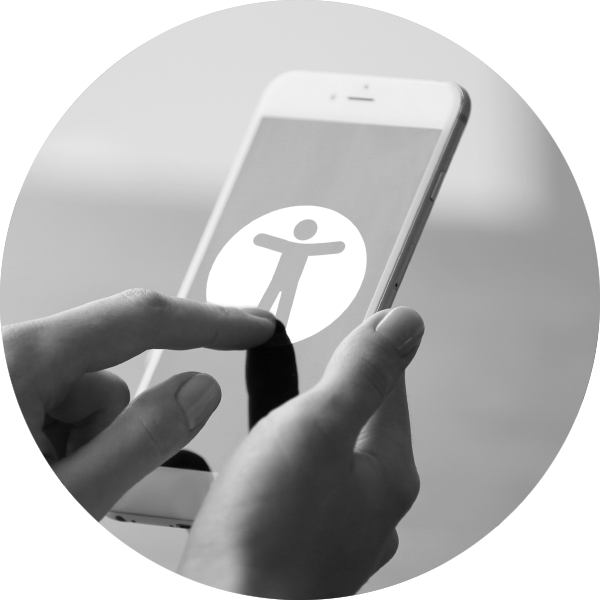
Overnight, businesses saw their website rankings change. Some dropped off search results entirely. Suddenly, every business wanted a mobile-friendly website.
On the back of this cautionary tale, Google is now monitoring the accessibility of every website on the internet. Given this (and the importance of the topic) is it time to review how seriously your business takes online accessibility?
What is website accessibility?
Content available on the internet should be accessible to everyone. However, many websites, applications, and tools are poorly designed, and so inaccessible to large swathes of the population. In fact, even some of the largest websites have accessibility challenges.
People can lack access for many reasons. They might not have appropriate hardware or be hampered by their ability.
They can also have disabilities or difficulties in certain situations.
Whilst it’s the right thing to make your digital experience widely accessible, it benefits your business too. And now, Google’s on the case.


How big a problem is web accessibility?
Over 1 billion people have some form of disability (World Health Organisation). That’s 15% of the global population.
Delving further, 21% of UK working age adults are disabled. Over 2 million people in the UK live with sight loss, 10% have some form of dyslexia and 4.5% of Brits are colour blind.
Where disability’s concerned, that’s just the tip of the iceberg.
The World Health Organisation predicts disability is on the rise and most of us will experience a temporary or permanent impairment in our lifetime. It’s a sobering thought.
Website accessibility isn’t just about disability though. You might find yourself in a situation where you cannot access content in the usual way.
For example, you’re in a busy office so can’t listen to videos. You’ve broken your wrist, so can’t use the keyboard for weeks. Or you’re working from home, your wife had to nip out, and you’re left holding the baby with no free arms!
At some point, challenges like these can prevent your entire target audience from accessing your online resources effectively.
How web accessibility helps your business.
There are endless challenges for businesses today. It’s easy to see how website accessibility has become a “nice to have”. Something that would exist in an ideal world.
Things like this only come to the fore when there’s a pressing need. Not because it’s the right thing to do.
So, is Google creating a worthy priority? They did when mobile-first launched.
That aside, website accessibility helps your business performance in other ways.
When you give everyone a better online experience, your credibility, trust, and engagement improve.
People will interact with your website or application longer, building a stronger relationship with your brand.
It’s not just customer-facing tech either. Making your internal portals and tools accessible boosts employee productivity too.
It just makes sense. Web accessibility should become part of your culture, something you consider as standard. And when embedded into a new project, it doesn’t cost more or take longer to achieve. You simply need to work with people who know how to achieve it.
Practicing what we preach, this is our approach on every new project today.


Won’t assistive technology cover this?
Many tools exist to help people effectively access online content. Screen readers can read aloud, screen magnifiers overcome small text, and eye tracking tools negate the need for a keyboard and mouse.
It’s a huge step forward. But technology alone doesn’t solve the problem.
Before creating this article, we reviewed many websites, using assistive technology. Tesco was one such example. The banner on the home shopping page had a heading: “Whoosh it”. Unfortunately, when the screen reader read the coding, this split into two four-letter words. The first was “Whoo”. You can work out the second…
It’s the perfect example of screen readers being, well, not perfect. Led from your coding, they can read content not as intended. Headlines without subsequent content, your navigation at the start of every page (how tedious), and images confusing matters due to poor naming protocols.
Try reading your own website through a screen reader to appreciate your particular problems. When we did this for our website, we realised screen readers need a (code-only) full stop after each header to make audio sense.
Assistive technology is valuable, but it’s not the full story because it works from your lead. You must build (and code) an accessible website in the first place.
Is there a web accessibility standard?
Presented as guidelines, not requirements, the World Wide Web Consortium (W3C) has developed international standards for web accessibility.
It provides numerous resources for developing more accessible online content.
We also like the A11Y Project guidance for its plain English approach. It strives to be a living example of beautiful, accessible, and inclusive digital experiences. The site also provides a useful checklist worth pointing website developers to.
5 simple ways to make your website more accessible.
Accessibility covers countless factors and priorities vary for every organisation. For example, improvements must typically balance with company branding. The most accessible colour palette is black and white, but that can provide an incredibly limiting experience for many. You must, therefore, consider your approach carefully. And remember, it’s not just about the tech, it’s about creating a better experience for everyone.
#1 Watch your language.
A plain English approach will always be more accessible. Consider non-native English speakers or those unfamiliar with your industry language.
Avoid complex metaphors and acronyms that challenge understanding. There’s always a simpler way to convey your message.
#2 Write code for the globe.
Using globally recognised coding standards to build your website means that accessibility tools such as screen readers have the best chance of presenting your content accurately. There’s less room for ambiguity. It also means another reputable coder could easily pick up where the first left off.
#3 Headings for accessibility.
People think headings exist for styling and SEO. But they have a third, very important role: accessibility. Use H1 (one only), H2 and H3 in logical sequence. And don’t skip a level. Screen readers can then present your content exactly as intended creating better user experience.
#4 Manage your keyboard input.
To avoid people (and assistive technology) getting lost on your website ensure focus styles exist for interactive elements accessed via the keyboard. For example, highlighting a button when it’s in use, and moving this highlight when a tab click accesses another button.
#5 Accessible media and images.
Never let media auto-play and ensure it can always be paused. Plus, caption speech in videos to enable silent viewing (or to help those with hearing difficulties).
Accompany your images with meaningful alt tags and provide text alternatives for charts and graphs. This helps those viewing without images enabled, or with visual impairment.


Not if, but when.
Today, web accessibility is rapidly becoming a “must have”. There’s no doubt about whether you need to address this issue. Not if you want your website to perform at its best – for your business and your audience.
Given Google’s current focus on website accessibility, consider it an insurance to get this right. You’ll futureproof your digital resources by making them accessible to everyone. And it significantly lessens the risk of you dropping off the search rankings when (not if) Google chooses to change its algorithm.
Finally, there’s no denying that an accessible website delivers a much better experience for everyone. It’s got to be the right thing to do.
Should you have any questions about web accessibility, we’d be happy to help you.
